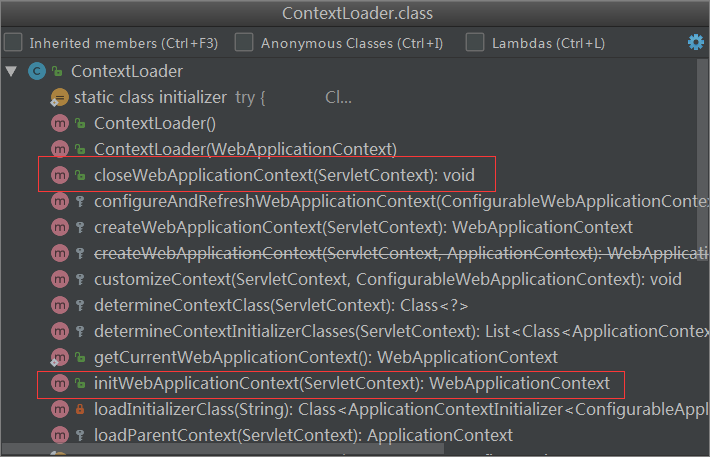Web容器初始化过程
一、SpringMVC启动过程
Spring的MVC是基于Servlet功能实现的,每个web工程中都有一个web.xml文件,web容器在启动的时候会加载这个配置文件,当一个web应用加载到web容器中后,在web应用开始响应客户端的请求之前,要按照顺序执行下面几个步骤:
1、实例化部署描述符中的<listener>元素标识的时间监听器的实例;
<listener> <listener-class>org.springframework.web.context.ContextLoaderListener</listener-class> </listener>
2、在实现了ServletContextListener接口的监听器实例中,调用contextInitialized()方法。ContextLoaderListener实现了ServletContextListener接口,ServletContextListener作为Servlet的监听者,会在ServletContext创建、销毁过程中监听ServletContextEvent事件,然后进行响应的处理。换句话说,就是在启动web容器时,ContextLoaderListener类会自动装配ApplicationContext的配置信息。
public class ContextLoaderListener extends ContextLoader implements ServletContextListener { public ContextLoaderListener() { } public ContextLoaderListener(WebApplicationContext context) { super(context); } // 这里调用其父类ContextLoader的initWebApplicationContext进行初始化工作 public void contextInitialized(ServletContextEvent event) { this.initWebApplicationContext(event.getServletContext()); } public void contextDestroyed(ServletContextEvent event) { this.closeWebApplicationContext(event.getServletContext()); ContextCleanupListener.cleanupAttributes(event.getServletContext()); } }
ContextLoaderListener类继承了ContextLoader,后者是实际的ServletContextListener接口实现者,这里用到了代理模式,利用ContextLoader类创建Spring application context,并将其注册到ServletContext中去。ContextLoaderListener就是调用ContextLoader类的initWebApplicationContext()方法和closeWebApplicationContext()方法来实现ServletContext的创建和销毁工作的。

其中,initWebApplicationContext()方法主要完成了两个部分的工作:一是查看是否已经指定父容器,如果不存在则设置其父容器。二是将Spring WebApplicationContext放置到线程Map中。
public WebApplicationContext initWebApplicationContext(ServletContext servletContext) { if (servletContext.getAttribute(WebApplicationContext.ROOT_WEB_APPLICATION_CONTEXT_ATTRIBUTE) != null) { throw new IllegalStateException("Cannot initialize context because there is already a root application context present - check whether you have multiple ContextLoader* definitions in your web.xml!"); } else { Log logger = LogFactory.getLog(ContextLoader.class); servletContext.log("Initializing Spring root WebApplicationContext"); if (logger.isInfoEnabled()) { logger.info("Root WebApplicationContext: initialization started"); } long startTime = System.currentTimeMillis(); try { if (this.context == null) { this.context = this.createWebApplicationContext(servletContext); } if (this.context instanceof ConfigurableWebApplicationContext) { ConfigurableWebApplicationContext cwac = (ConfigurableWebApplicationContext)this.context; if (!cwac.isActive()) { //查看是否指定父容器 if (cwac.getParent() == null) { ApplicationContext parent = this.loadParentContext(servletContext); cwac.setParent(parent); } this.configureAndRefreshWebApplicationContext(cwac, servletContext); } } servletContext.setAttribute(WebApplicationContext.ROOT_WEB_APPLICATION_CONTEXT_ATTRIBUTE, this.context); ClassLoader ccl = Thread.currentThread().getContextClassLoader(); //将WebApplicationContext放置到线程Map中 if (ccl == ContextLoader.class.getClassLoader()) { currentContext = this.context; } else if (ccl != null) { currentContextPerThread.put(ccl, this.context); } if (logger.isDebugEnabled()) { logger.debug("Published root WebApplicationContext as ServletContext attribute with name [" + WebApplicationContext.ROOT_WEB_APPLICATION_CONTEXT_ATTRIBUTE + "]"); } if (logger.isInfoEnabled()) { long elapsedTime = System.currentTimeMillis() - startTime; logger.info("Root WebApplicationContext: initialization completed in " + elapsedTime + " ms"); } return this.context; } catch (RuntimeException var8) { logger.error("Context initialization failed", var8); servletContext.setAttribute(WebApplicationContext.ROOT_WEB_APPLICATION_CONTEXT_ATTRIBUTE, var8); throw var8; } catch (Error var9) { logger.error("Context initialization failed", var9); servletContext.setAttribute(WebApplicationContext.ROOT_WEB_APPLICATION_CONTEXT_ATTRIBUTE, var9); throw var9; } } }
在初始化方法执行后,将WebApplicationContext存到了两个地方,分别是ServletContext和currentContextPerThread中,我们可以通过这两个地方来获取WebApplicationContext:1.从servletContext中去拿;2.从当前的线程Map中去拿。
3、实例化部署符中<filter>元素标识的过滤器实例,并调用每个过滤器实例的init()方法。
4、实例化部署符中<servlet>元素标识的Servlet实例,按照该元素包含的load-on-startup顺序,调用每个Servlet实例的init()方法。
<servlet-class>org.springframework.web.servlet.DispatcherServlet</servlet-class>
在SpringMVC的架构中,DispatcherServlet主要负责客户端请求的分发,起到控制器的作用。DispatcherServlet是实现Servlet接口的实现类,其结构如下图所示。Servlet的生命周期由Servlet的容器来控制,主要分为初始化、运行和销毁三个阶段,分别对应三个方法:init()、service()和destory()。

在DispatcherServlet的父类HTTPServletBean中,重写了init()方法,主要实现将当前的Servlet类实例转换为BeanWrapper类型实例,以便使用Spring中提供的注入功能进行相应属性的注入。
在DispatcherServlet的父类FameworkServelet中,重写了service()方法,对于不同的方法,Spring统一将程序引导至processRequest(request,response)中,processRequest方法再对处理请求进行了一些准备工作后,又将细节实现转移到了doService方法中。
protected void service(HttpServletRequest request, HttpServletResponse response) throws ServletException, IOException { String method = request.getMethod(); if (method.equalsIgnoreCase(RequestMethod.PATCH.name())) { this.processRequest(request, response); } else { super.service(request, response); } } protected final void processRequest(HttpServletRequest request, HttpServletResponse response) throws ServletException, IOException { long startTime = System.currentTimeMillis(); Throwable failureCause = null; LocaleContext previousLocaleContext = LocaleContextHolder.getLocaleContext(); LocaleContext localeContext = this.buildLocaleContext(request); RequestAttributes previousAttributes = RequestContextHolder.getRequestAttributes(); ServletRequestAttributes requestAttributes = this.buildRequestAttributes(request, response, previousAttributes); WebAsyncManager asyncManager = WebAsyncUtils.getAsyncManager(request); asyncManager.registerCallableInterceptor(FrameworkServlet.class.getName(), new FrameworkServlet.RequestBindingInterceptor()); this.initContextHolders(request, localeContext, requestAttributes); try { //调用DispatcherServlet的doService()方法 this.doService(request, response); } catch (ServletException var17) { failureCause = var17; throw var17; } catch (IOException var18) { failureCause = var18; throw var18; } catch (Throwable var19) { failureCause = var19; throw new NestedServletException("Request processing failed", var19); } finally { this.resetContextHolders(request, previousLocaleContext, previousAttributes); if (requestAttributes != null) { requestAttributes.requestCompleted(); } if (this.logger.isDebugEnabled()) { if (failureCause != null) { this.logger.debug("Could not complete request", (Throwable)failureCause); } else if (asyncManager.isConcurrentHandlingStarted()) { this.logger.debug("Leaving response open for concurrent processing"); } else { this.logger.debug("Successfully completed request"); } } this.publishRequestHandledEvent(request, response, startTime, (Throwable)failureCause); } }
protected void doService(HttpServletRequest request, HttpServletResponse response) throws Exception { if (this.logger.isDebugEnabled()) { String resumed = WebAsyncUtils.getAsyncManager(request).hasConcurrentResult() ? " resumed" : ""; this.logger.debug("DispatcherServlet with name '" + this.getServletName() + "'" + resumed + " processing " + request.getMethod() + " request for [" + getRequestUri(request) + "]"); } Map<String, Object> attributesSnapshot = null; if (WebUtils.isIncludeRequest(request)) { attributesSnapshot = new HashMap(); Enumeration attrNames = request.getAttributeNames(); label108: while(true) { String attrName; do { if (!attrNames.hasMoreElements()) { break label108; } attrName = (String)attrNames.nextElement(); } while(!this.cleanupAfterInclude && !attrName.startsWith("org.springframework.web.servlet")); attributesSnapshot.put(attrName, request.getAttribute(attrName)); } } request.setAttribute(WEB_APPLICATION_CONTEXT_ATTRIBUTE, this.getWebApplicationContext()); request.setAttribute(LOCALE_RESOLVER_ATTRIBUTE, this.localeResolver); request.setAttribute(THEME_RESOLVER_ATTRIBUTE, this.themeResolver); request.setAttribute(THEME_SOURCE_ATTRIBUTE, this.getThemeSource()); FlashMap inputFlashMap = this.flashMapManager.retrieveAndUpdate(request, response); if (inputFlashMap != null) { request.setAttribute(INPUT_FLASH_MAP_ATTRIBUTE, Collections.unmodifiableMap(inputFlashMap)); } request.setAttribute(OUTPUT_FLASH_MAP_ATTRIBUTE, new FlashMap()); request.setAttribute(FLASH_MAP_MANAGER_ATTRIBUTE, this.flashMapManager); try { // 最终的请求处理函数 this.doDispatch(request, response); } finally { if (!WebAsyncUtils.getAsyncManager(request).isConcurrentHandlingStarted() && attributesSnapshot != null) { this.restoreAttributesAfterInclude(request, attributesSnapshot); } } }
经过层层的准备工作,最终在doDispatch()方法中实现了完整的请求处理过程:
protected void doDispatch(HttpServletRequest request, HttpServletResponse response) throws Exception { HttpServletRequest processedRequest = request; HandlerExecutionChain mappedHandler = null; boolean multipartRequestParsed = false; WebAsyncManager asyncManager = WebAsyncUtils.getAsyncManager(request); try { try { ModelAndView mv = null; Exception dispatchException = null; try { processedRequest = this.checkMultipart(request); multipartRequestParsed = processedRequest != request; //根据request信息寻找对应的处理器 mappedHandler = this.getHandler(processedRequest); if (mappedHandler == null || mappedHandler.getHandler() == null) { this.noHandlerFound(processedRequest, response); return; } //根据处理器寻找对应的处理器适配器 HandlerAdapter ha = this.getHandlerAdapter(mappedHandler.getHandler()); String method = request.getMethod(); boolean isGet = "GET".equals(method); if (isGet || "HEAD".equals(method)) { long lastModified = ha.getLastModified(request, mappedHandler.getHandler()); if (this.logger.isDebugEnabled()) { this.logger.debug("Last-Modified value for [" + getRequestUri(request) + "] is: " + lastModified); } if ((new ServletWebRequest(request, response)).checkNotModified(lastModified) && isGet) { return; } } if (!mappedHandler.applyPreHandle(processedRequest, response)) { return; } //返回视图 mv = ha.handle(processedRequest, response, mappedHandler.getHandler()); if (asyncManager.isConcurrentHandlingStarted()) { return; } this.applyDefaultViewName(request, mv); mappedHandler.applyPostHandle(processedRequest, response, mv); } catch (Exception var19) { dispatchException = var19; } this.processDispatchResult(processedRequest, response, mappedHandler, mv, dispatchException); } catch (Exception var20) { this.triggerAfterCompletion(processedRequest, response, mappedHandler, var20); } catch (Error var21) { this.triggerAfterCompletionWithError(processedRequest, response, mappedHandler, var21); } } finally { if (asyncManager.isConcurrentHandlingStarted()) { if (mappedHandler != null) { mappedHandler.applyAfterConcurrentHandlingStarted(processedRequest, response); } } else if (multipartRequestParsed) { this.cleanupMultipart(processedRequest); } } }
二、ServletContext、ApplicationContext和WebApplicationContext区别?
1、ServletContext:是一个Web应用的上下文,是一个全局信息的存储空间,代表当前的web应用。Servlet容器(如Tomcat)在启动一个Webapp时,会为它创建一个ServletContext对象,即servlet上下文环境。每个webapp都有唯一的ServletContext对象。同一个webapp的所有servlet对象共享一个ServeltContext,servlet对象可以通过ServletContext来访问容器中的各种资源。ServletContext在web应用启动时创建,在web应用服务关闭时释放。
2、ApplicationContext:它是建立在BeanFactory基础之上的,除了包含BeanFactory的所有功能之外,在国际化支持、资源访问、事件传播等方面进行了良好的支持。其体系结构如下图。

ApplicationContext接口有三个常用的实现类,如下:
| 类名称 | 功能描述 |
| ClassPathXmlApplicationContext |
从类路径ClassPath中寻找指定的XML配置文件,找到并装载
完成ApplicationContext的实例化工作
|
| FileSystemXmlApplicationContext |
从指定的文件系统路径中寻找指定的XML配置文件,找到并装载
完成ApplicationContext的实例化工作
|
| XmlWebApplicationContext | 从Web应用中寻找指定的XML配置文件,找到并装载完成ApplicationContext的实例化工作 |
与BeanFactory不同的是,ApplicationContext容器实例化后会自动对所有的单实例Bean进行实例化与依赖关系的装配,使之处于待用状态。而BeanFactory容器实例化后并不会自动实例化Bean,只有当Bean被使用时BeanFactory容器才会对该Bean进行实例化与依赖关系的装配。
3、WebApplicationContext:它是专门为web应用提供的,它允许从相对于web根目录路径中装载配置文件完成初始化;从WebApplicationContext中可以获得ServletContext的引用,同时为了方便web应用访问Spring应用上下文,WebApplicationContext也将作为一个属性放到ServletContext中,可以通过WebApplicationContextUtils的getWebApplicationContext(ServletContext sc)方法获取。

三、总结
ApplicationContext是Spring的核心,Context为上下文环境,在Web应用中,会用到WebApplicationContext,它继承自ApplicationContext。在SpringMVC启动过程中,ContextLoaderListener类起着至关重要的作用。它读取web.xml中配置的context-param中的配置文件,提前在web容器初始化前准备业务对应的Application context,将创建好的WebApplicationContext放置于ServletContext属性中,这样我们只要得到Servlet就可以得到WebApplicationContext对象,并利用这个对象访问spring容器管理的bean。







【推荐】国内首个AI IDE,深度理解中文开发场景,立即下载体验Trae
【推荐】编程新体验,更懂你的AI,立即体验豆包MarsCode编程助手
【推荐】抖音旗下AI助手豆包,你的智能百科全书,全免费不限次数
【推荐】轻量又高性能的 SSH 工具 IShell:AI 加持,快人一步
· AI与.NET技术实操系列:基于图像分类模型对图像进行分类
· go语言实现终端里的倒计时
· 如何编写易于单元测试的代码
· 10年+ .NET Coder 心语,封装的思维:从隐藏、稳定开始理解其本质意义
· .NET Core 中如何实现缓存的预热?
· 25岁的心里话
· 闲置电脑爆改个人服务器(超详细) #公网映射 #Vmware虚拟网络编辑器
· 零经验选手,Compose 一天开发一款小游戏!
· 通过 API 将Deepseek响应流式内容输出到前端
· AI Agent开发,如何调用三方的API Function,是通过提示词来发起调用的吗